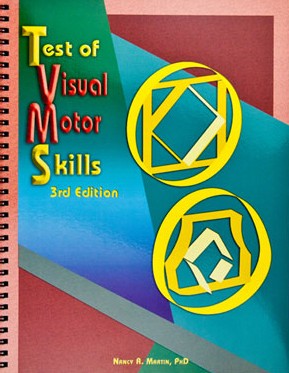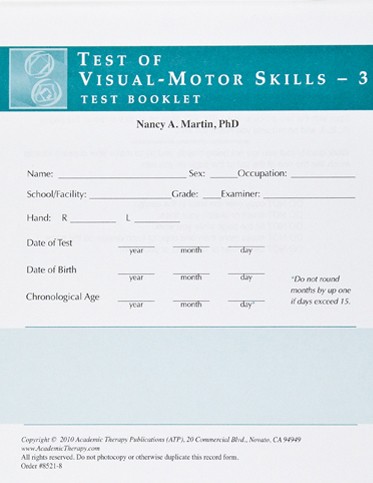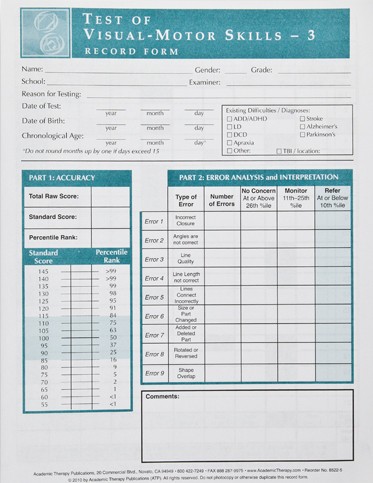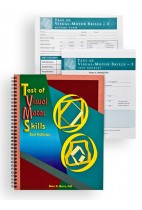Test of Visual-Motor Skills (TVMS-3)
Complete Kit
- Ages 3 to 90+
- Testing Time 30 - 45 minutes
- Administration Individual / Group
-
Product Code 8519-5 ( MR #052222 )
* Qualifications required to purchase this item. Click here to complete the qualifications form.
Price $170.00
Contents
-

Test of Visual-Motor Skills (TVMS-3)
TVMS-3 Examiner's Manual
$88.00 -

Test of Visual-Motor Skills (TVMS-3)
TVMS-3 Test Booklets (15)
$60.00 -

Test of Visual-Motor Skills (TVMS-3)
TVMS-3 Record Forms (15)
$22.00 -

Test of Visual-Motor Skills (TVMS-3)
TVMS-3 Container (Storage Box)
cardboard container
*Not available separately (package component only)
The Test of Visual Motor Skills—Third Edition (TVMS–3) assesses how well a person can coordinate visually guided fine-motor movements to copy a design while it is in sight. The TVMS-3 is used to determine whether there are any systematic distortions or gross inaccuracies in the copied design that could be the result of deficits in visual perception, motor planning, and/or execution.
The TVMS–3 utilizes a greatly simplified scoring system (NO ruler or protractor needed!). A single test now replaces the two levels of the previous version (TVMS–R and TVMS–UL), making it both easier to administer and more economical. This version also eliminates the need for the alternate quick-scoring method that was previously offered for the TVMS–R. The TVMS–3 was normed on a national sample of 2,610 individuals.
Administration and Scoring
The TVMS–3 is an untimed test and can administered and scored in about 30-45 minutes. The test-taker is given a booklet containing a series of 39 geometric designs of increasing complexity. The individual is asked to reproduce each design as closely as possible but may not sketch or trace the designs, nor attempt more than one copy for each design.
Results are expressed as a general accuracy standard score and analysis of errors seen in the copied designs. The manual contains detailed descriptions and exemplars of actual test results obtained during the norming study, showing the error types and scoring guidelines. The scoring sheet has a built-in guide to the types of errors possible on each design.
Nine types of errors are identified:
• Incorrect Closure
• Incorrect Angle
• Line Quality
• Line Length
• Line Connection
• Modification of Size or Part
• Addition or Deletion of a Part
• Rotation or Reversal
• Shape Overlap Error
Analysis of the types of errors made provides a detailed evaluation of visualmotor skills. Results can be reported as standard scores, percentile ranks, or age equivalents. When used along with a test of visual perception, the tests can differentiate between a primarily visual-motor impairment and a perceptual difficulty. The TVMS-3 Scoring Tutorial (provided in the manual) details the scoring process using annotated exemplars for all error types and includes practice exercises.

 Proud to be Canadian
Proud to be Canadian